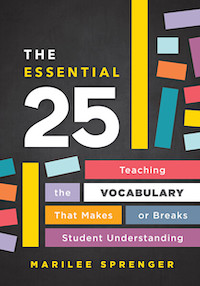25 Essential Words and How to Teach Them
The Essential 25: Teaching the Vocabulary That Makes or Breaks Student Understanding
By Marilee Sprenger
(ASCD, 2021 – Learn more)
Reviewed by Kathleen Palmieri

With The Essential 25 I took a different approach – one that’s more “action research leading to a review.” I immersed my class in developing a greater understanding of Sprenger’s essential 25 words.

Revisiting Tiers 1, 2 and 3
Having this initial “deep dive” into how one learns helped to pave the way for what was to come – the word knowledge. Again, a review of the three tiers of words was helpful. Tier 1 is presented as the basic vocabulary words most kids know, Tier 2 are high frequency words used in more complex texts, adult conversations, and literature; and Tier 3 offers the content specific words, also considered “low frequency words.” This was important as Marilee Sprenger leads us into the why behind choosing her “essential 25.”
The essential 25 words all come from the high frequency words found in Tier 2. Just considering the places that Tier 2 words occur – such as literature and in more complex texts – their importance is very clear.
As Sprenger states, “These are forever words – the words that students need to know to get things done, to comprehend state standards, to read complex texts, to think critically, to write articulately and powerfully, and to engage in academic discussions.” (page 25)
The Foundational 11
Beginning in chapter 4, the first list is introduced as “The Foundational 11” and is said to be “…the words (that) lay the groundwork for many of the words in lists 2 and 3.” (page 39) As an example, the words “compare” and “contrast” are two of the foundational 11. These words are defined and shown as part of a word family, synonyms are offered, and a “jingle” is provided.
Working with these words, the reader sees how the words are used in standards and assessments. Sprenger also includes an “Appeal to emotional memory with stories” where the words are personified to help students relate to their meaning on an emotional level.
Next, a section is provided for how to teach compare and contrast in the classroom. The chapter includes a T-chart exercise along with the idea of a “Summary List,” a Venn Diagram illustrating different and same, as well as a “Compare and Contrast Organizer” that offers more space to write similarities and differences.
Finally (my students’ favorite) there is the “Vocabulary Word Map.” This organizer provides a center space for the word, then spaces for Class Definition, My Definition, My Sentence and My Picture. All of these templates are included, along with downloading information, in the appendix of the book.
The Necessary 9
Chapter 5 provides the second list of words known as ”List 2: The Necessary 9.” The words contained in this list “encompass concepts and skills that are necessary for reading comprehension, writing assessments, and life beyond school.” For example, the word evidence is found on this list, and the same format is used as in list 1 for definition, meaning, synonyms and jingle.
The word evidence appears in the standards as well as in Level 3 of Webb’s Depth of Knowledge (DOK) chart. Sprenger also includes the “Appeal to Emotional Memory with Stories.” She covers ways to teach evidence such as the Mystery Box activity with the creation of special boxes of evidence connected to mystery characters. This was another activity that my students embraced, and they eventually put boxes together themselves to lead their own small group.
The Quiet Game was my favorite as I gave students short stories and articles to read in class and later provided them with questions I had written on chart paper. I placed students in groups and gave them time to silently respond to the questions on the chart paper I had posted strategically around the classroom. Each group wrote in a different color marker that helped me track the various groups’ thinking.
As Sprenger suggests, “Students may ask questions on the paper for members of their group or other groups to respond to; they may draw lines connecting ideas or ask for evidence for some comments.” (page 105) Once the students were done, we shared comments on the chart paper. As instructed in the book, we emphasized the responses that supported evidence rather than opinions, which reinforced the importance of evidence.
The Ultimate 5
The third list, “List 3: The Ultimate 5,” are words that “are critical to the work students are asked to do on assessments, in their writing, and in college and careers.” These words include analyze, cite, evaluate, persuade, and relevant.
Again the format for introducing each word is the same as the previous lists, and Sprenger includes activities and templates to help teach these words in the classroom. Favorite activities in my classroom included the “The Bean Bag Toss” and the “Magic Letter.” Details and ways to teach using these activities are thoroughly explained in the book.
Seeing My Students’ Learning
Throughout The Essential 25 Sprenger is clear on how best to teach a word. The reminder “The Best Way to Teach This Word Is to Use This Word” is found under each of the essential words in all of the lists.
After spending a great deal of time reading and incorporating the essential 25 words and activities into my classroom, I have seen growth in my students’ understanding of these key vocabulary words. Coming to this in the last trimester of school – and especially as we prepared for state testing – my students have demonstrated greater confidence in their daily work and have increased their word knowledge (as they’ve demonstrated in their reading comprehension and writing).
In the past I have read other books by Marilee Sprenger, notably 101 Strategies to Make Academic Vocabulary Stick. That book also stressed the importance of building children’s vocabulary, relating back to the three tiers of words. It also highlighted the importance of making time for vocabulary instruction. The Essential 25 exponentially builds on this idea and offers realistic, easy-to-follow ideas on how to implement the lists of essential 25 words.
I’ve spent a great deal of time with this exceptional book, and I would highly recommend it to any intermediate and above educator. I have seen the results of making time for vocabulary instruction, and I will continue to incorporate the essential 25 words with future classes.
Last fall Marilee Sprenger wrote an article about the 25 Words That Trigger Student Understanding here at MiddleWeb. Her other MiddleWeb articles are here.
Kathleen Palmieri is a National Board Certified Teacher and NBCT Professional Learning facilitator. She is a fifth grade educator in upstate New York who reviews and writes regularly for MiddleWeb. With a passion for literacy and learning in the classroom, she participates in various writing workshops, curriculum writing endeavors, and math presentations. As a lifelong learner, she is an avid reader and researcher of educational practices and techniques. Collaborating with colleagues and globally on Twitter @Kathie042500 and expanding her education adventures at www.kathleenpalmieri.com are ongoing practices.




































